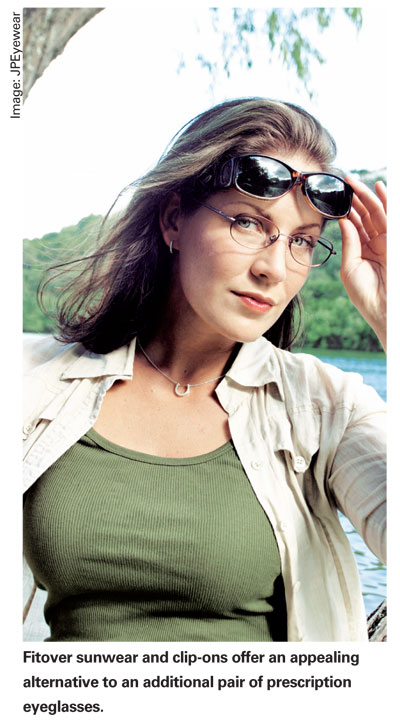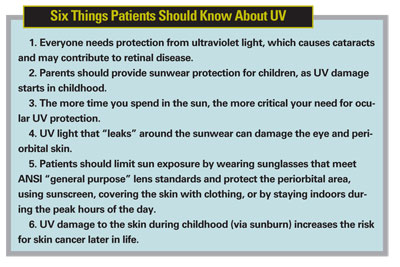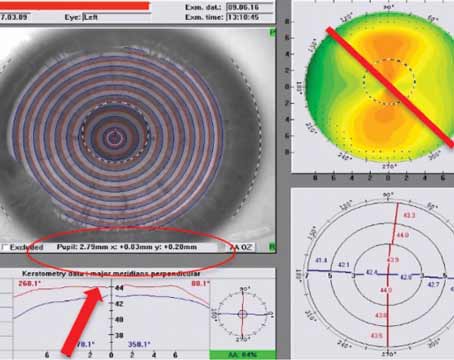Certainly, every optical department could benefit by selling more pairs of high-end prescription sunglasses. However, there's a segment of the patient population that's not going to respond, no matter how effective your efforts may be with other patients.
Why? Because a significant number of ophthalmology patients are seniors, and some seniors regard high-fashion sunglasses as a foolish way to spend money. Some other seniors are on limited incomes, and other patients simply do not have the disposable dollars due to tight household budgets.
These patients' eyes deserve protection from UV rays. Research shows that damage from UV rays occurs during years of sun exposure, starting from the earliest age. Children represent your best opportunity to prevent UV damage when it will do the most good.
However, patients of all ages can benefit from UV protection. Recent studies show that sun exposure after the teenage years correlates with a higher incidence of cataracts in older adults. UV exposure may contribute to retinal disorders, including age-related macular degeneration. Ocular melanoma is more common in areas near the equator (where UV exposure is greatest), and may be more of a risk in patients with light-colored eyes. Melanoma of the periorbital skin may be avoided with proper UV protection. 
It behooves your practice to offer affordable sunwear options. For patients who wear prescription eyeglasses, there are polarized "fitover" sunwear and clip-ons, which offer an appealing alternative to an additional pair of prescription eyeglasses with polarizing and/or tinted lenses.
Fitovers and clip-ons are particularly appropriate for patients who wear photochromic lenses, which will not darken to sun lenses behind a vehicle windshield. Fitovers and many clip-ons are polarized, and will reduce glare for drivers by blocking light reflected from surfaces like the hood of a car or a highway.
Fitovers fit right over the patient's prescription eyewear, transforming them into sunwear at a moderate price. Fitovers are available in a number of shapes to accommodate different frame shapes. Select a fitover product that offers polarizing lenses and side shields, a choice of lens colors and wrap-around UV protection.
Clip-ons and drop-ins also are available in a variety of shapes to fit many styles of frames. They are offered in polarizing lenses with UV protection.
Patients need to know:
• There are moderately priced products that will convert their current eyeglasses into sunwear.
• Should the patient's Rx change, the sunwear product is still current.
• These products offer all the benefits of polarizing lenses.
• Patients' eyes are better-protected from UV damage with side shields found on some of these products.
For patients who do not need corrective lenses (due to intraocular lens implants or refractive surgery),
This huge market is dominated by grocery/drug/convenience stores, followed distantly by sunglass retailers and department stores. Out of nearly 95 million pairs sold in 2004, independent practices and optical chains combined sold just 3 million pairs. This represents a huge opportunity for optical retailers to expand this eyewear sales category, as well as to educate consumers about the eye health benefits of sunglass lenses.
The most significant challenge is that consumers are conditioned to purchase sunwear at non-optical outlets. This buying habit is reinforced by seasonal marketing and merchandising by retailers, as well as year-round presence in stores consumers visit frequently. 
The average retail price of
Considering the significant market for moderately priced sunwear, you can certainly get a bigger piece of the pie—and protect more patients' eyes —by offering
Patient communication is key:
• Teach patients about the dangers of UV rays (See sidebar, above).
• Be sure they know that your practice offers moderately priced products that will protect their eyes.
Your more active patients need safety protection plus UV protection. Sports goggles offer both, and for some people, may be a better recommendation than sunglasses. Whether the patient swims, cycles, water-skis (or skis), or just plain shoots hoops in the driveway, goggle technology now offers a wide variety of products to choose from. Be sure to consider three things when dispensing goggles:
1. Impact protection. Dress eyewear (ANSI Z80) and even occupational eyewear (ANSI Z87) will probably not be sufficient. Sports goggles should meet ASTM F803-88a standards.
2. Exposure protection. Primarily from experience with LASIK and other refractive surgeries, we now know a stable precorneal tear film is essential to good vision and acuity. Recreational goggles must fit the orbital structure of a person's face optimally, providing not only a comfortable fit, but also allowing proper air and wind management for their sport.
3. Vision/acuity enhancement. Many of the sports-specific goggles contain well-tested tint recommendations. Hues and densities should not only be chosen with respect to the intended purpose, they should be trial-tested on the individual patient. For Rx goggles, you may need to compensate for non-standard vertex distances (closer than normal) and/or face-form angle ("wrap") for goggles.







